Explore intriguing mini-restaurant design ideas that can turn your home into an elegant dining experience.
Transforming your home into a charming mini restaurant is an exciting venture that can add a unique touch to your dwelling. This article is packed with innovative design ideas to help you create a warm, inviting, and stylish mini restaurant right in your own home.
From choosing the right color scheme and lighting, to selecting the perfect furniture and decor, each detail counts. We will also delve into space-saving solutions, creative menu boards, and even how to create a stunning centerpiece.
So, whether you’re an aspiring chef or simply a food enthusiast, these tips will guide you in creating a mini restaurant that’s not only functional, but also aesthetically pleasing.
Compact Bar Counter Design

Selecting a compact bar counter ensures the efficient use of space, without compromising on style or functionality. The critical design considerations should be:
- Material: Choose from a variety of options, like solid wood, metal, or acrylic, depending on the overall aesthetic of your mini restaurant.
- Placement: Position your bar counter adjacent to a wall or partition it off with a high-top table to optimize the floor plan.
- Storage: Incorporate built-in shelves or racks for glassware and bottles, which not only increases practicality, but also adds a visual allure.
- Lighting: Integrate thoughtful lighting into the bar counter to achieve a chic and inviting ambiance.
- Ergonomics: Ensure the counter height supports comfortable seating for an enjoyable dining experience.
- Finishing touches: Add bar stools, funky signs, or a menu board to complete your compact bar counter look.
Industrial-themed Interiors

The rugged appeal of industrial-themed interiors resonates well within a mini restaurant setting. It borrows inspiration from old factories and industrial spaces, presenting a raw, unfinished look that’s striking yet understated.
1. Exposed Brick: A quintessential feature for that weathered, vintage feel, exposed brick can be used in walls, bar counters, or accents around the restaurant.
2. Open Pipes and Ducts: Plumbing or electrical pipes, air ducts, or vents left on display give off that unrefined, warehouse-style ambiance.
3. Metal Aspects: Incorporate steel, iron, copper in custom furniture, light fixtures, and shelving. They add strength to the theme without overpowering the room.
4. Unadorned Wood: Used in counters, tables, or pillars, unpolished, raw wood complements the hard steel and rigid brick with its organic texture.
5. High Ceilings: If the space allows, high ceilings are synonymous with industrial-style interiors. Adding hanging lights or exposed beams only enhance that cavernous factory vibe.
6. Concrete Flooring: Durable and easy to maintain, concrete floors provide a clean, neutral base against the robustness of other features.
7. Big Windows: Large, often uncurtained windows allow for ample natural light, a signature element of industrial design spaces.
Table-top Cooking for Unique Dining Experience

Making meal preparation a part of the dining adventure increases interaction and adds a dash of novelty to the experience. Consider integrating propane-based or induction cooktops directly into the dining tables for safe, convenient cooking right where your guests are seated. Ensure these are paired with well-placed ventilation solutions to remove smoke and odors efficiently.
Key points:
- Integration of cooking and dining space stimulates engagement.
- Keeping safety paramount with use of propane or induction cooktops.
- Proper ventilation important to prevent smoke or odor build-up.
- A balance between cooking action and dining comfort is a crucial point to consider.
Natural Elements for a Fresh Feel

Incorporating natural elements into your mini restaurant design can bring a refreshing feel to the space. Use materials like stone, wood, and bamboo to introduce an earthy aesthetic.
Live plants, whether they are succulents on table tops or vertical green walls, can add a pop of vibrance.
Consider water features like mini fountains or aquariums to bring soothing sounds and a touch of tranquillity.
Key Points:
- Use of natural materials: stone, wood, bamboo.
- Incorporation of live plants: succulents, green walls.
- Addition of water features: fountains, aquariums.
Rustic Wooden Design and Stone Countertops

Embracing a raw, untouched aesthetic, the use of natural materials can significantly enhance the mini restaurant’s appeal.
Wood’s organic charm offers a warm, homely feel. Opt for reclaimed or aged lumber, as they tend to carry more character and personality with their distinct finishes.
From furniture to fixtures, wooden elements can effortlessly inject a rustic vibe.
As for the stone, it brings out an earthy vibe, grounding the overall look of the space. Ideal choices range from granite to marble, each offering unique visual textures and durability.
Utilize these for your bar or kitchen countertops; they do not only uplift the look but also promise long-lasting performance.
Key Points:
- Reclaimed lumber for distinct finishes.
- Utilize wooden elements for furniture and fixtures.
- Granite or marble for earthy, durable countertops.
Space-saving Foldable Furniture

In tight spaces, maximizing every square inch is a paramount need. Enter the realm of foldable furniture. Its clever engineering offers a practical solution for mini restaurant design. Single-use items are the past; multi-functionality is the future.
1. Fold-down tables: Built into the wall, they offer dining space when needed, and fold up to free up space instantly.
2. Convertible chairs: A compact form, they can transform into dining chairs or stack up neatly when not in use.
3. Collapsible shelves: Perfect for storing kitchen essentials or showcasing décor—useful and accommodating.
4. Mobile kitchen islands: Offer extra prep space, storage, and seating area, all in one movable unit.
The key focus here is on utility. Choose designs that are easy to operate, durable and suit the overall aesthetic. This way, style and function will blend seamlessly in your mini restaurant.
Cozy Outdoor Seating Area

Harnessing your outdoor space can create a delightful dining experience, akin to alfresco eateries. Select weather-resistant furniture, with an emphasis on comfort. Look for cushioned chairs, small tables, and possibly a fire pit for the colder months. Bear in mind space constraints when selecting pieces.
Key Points:
- Comfortable, weather-resistant furniture.
- Utilize small tables and saving space.
- Introduce a heat source, such as a fire pit for colder seasons.
Creating an intimate atmosphere can be achieved through clever lighting, such as string lights or lanterns providing a soft glow. Install overhead pergolas or canopies not just for shade or protection from the elements, but also to hang light sources or greenery.
Key Points:
- Strategic, ambient lighting with options like string lights or lanterns.
- Overhead structures for protection and design elements.
Plant decor surrounding your seating area can offer a refreshing and lush appearance. Opt for potted plants, especially those with pleasant fragrance. Succulents, herbs and blooming flowers make for an appealing visual and sensory experience.
Key Points:
- Greenery decor using potted plants, herbs, and flowers.
- Select plants for aesthetics as well as fragrance.
With these elements, your outdoor seating area becomes a charming extension of your mini restaurant, offering a different kind of dining experience to your customers.
Kitchen View Seating for Interactive Dining

Adopting a design where customers can see the kitchen brings a new dynamic to the dining experience. It has a few major advantages, including:
- Transparency: Customers appreciate openness and honesty. Seeing their food being prepared instills trust in the restaurant’s hygiene practices and quality of ingredients.
- Entertainment: Watching a professional chef in action can be a form of performance art, keeping guests entertained while they wait for their order.
- Engagement: The open concept allows for customer-chef interactions. Opportunities to ask about food preparation techniques or recipe origins can turn a meal into a learning experience.
This design option necessitates a meticulously maintained kitchen, as every aspect will be in a customer’s line of sight. Regular kitchen cleaning schedules must be adopted to keep things looking top-notch and food tasting at its best.
Vintage, Retro Style Decor
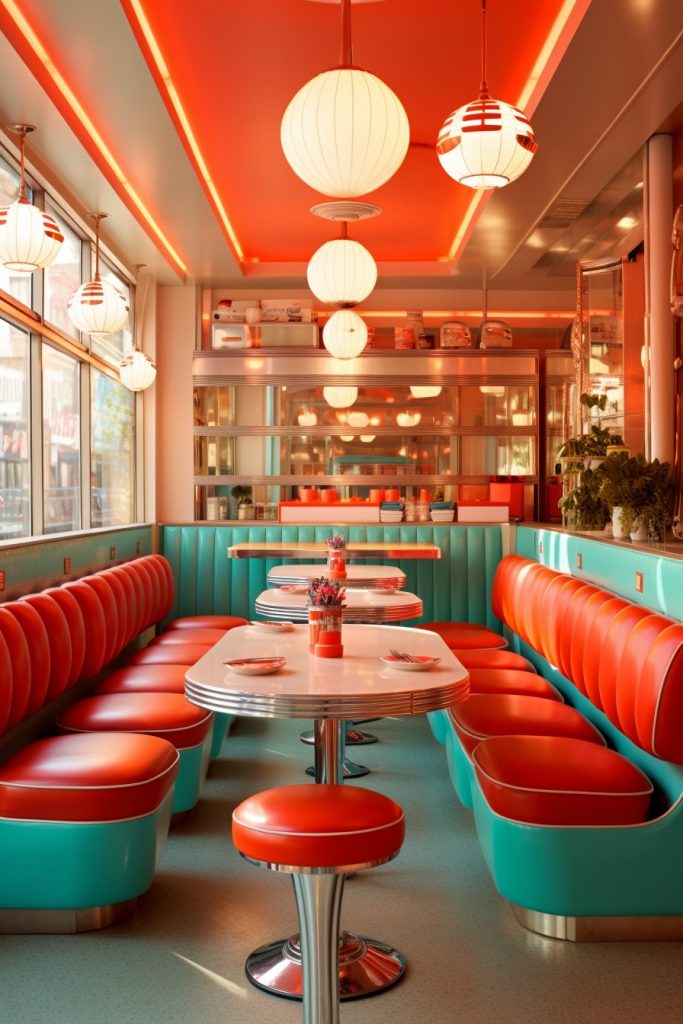
Drawing on the largely untamed aesthetic of the mid-20th century, this decor style is characterised by nostalgia-inducing elements. Unleash the artistic side by involving iconic pieces from the past. Vintage advertisements, vinyl record displays, or nostalgic wall arts infuse the theme without overdoing it.
Key Points:
- Furniture: Opt for classic dinette sets – chrome accents, vinyl chairs, or pastel-hued bar stools.
- Lighting: Pendant lamps, neon signs, or lava lamps contribute to retro ambiance.
- Color Palette: Embrace bold, saturated hues of the 60s and 70s or muted tones of the 50s.
- Accessories: Antique appliances, jukeboxes, rotary phones make for perfect retro accessories.
- Walls and Flooring: Versatile checkerboard tiles, wall panels, wallpaper with bold prints anchor the aesthetic.
Remember, the key to retro decor is balance between old and new, and playfulness in design.
Rooftop Diner With Urban Views
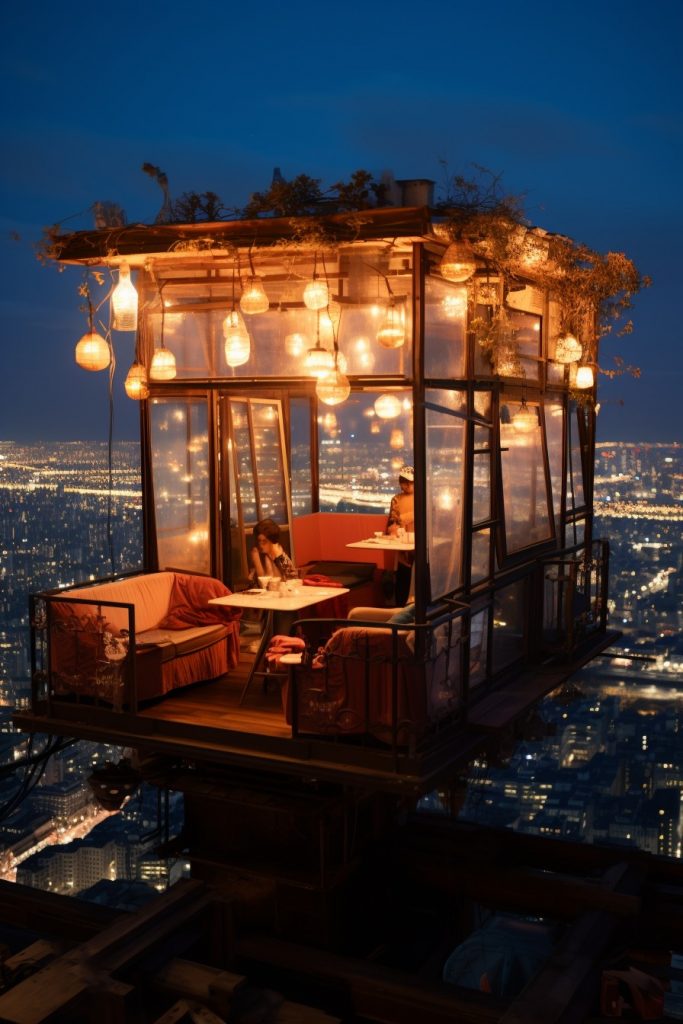
Optimizing the available space can lead to breathtaking dining experiences. For instance, harnessing the potential of the rooftop can create a unique environment that provides guests with spectacular urban vistas.
Key Points:
- View: The cityscape becomes a dynamic backdrop, constantly changing with the time of day and weather conditions.
- Ambience: Proper setup and decor can enhance the feeling of dining ‘under the stars’.
- Design: Comfortable furniture and strategic positioning of tables secure privacy while ensuring each guest enjoys the view.
- Lighting: Soft, ambient lighting will complement the city lights, enhancing the rooftop diner’s atmosphere while keeping the view unobstructed.
- Weather Protection: Investing in quality sunshades, umbrellas or even a retractable roof system helps to protect diners from harsh weather conditions, thereby ensuring a pleasurable dining experience regardless of the climate.
- Logistics: Easy accessibility, possibly with a dedicated elevator, is crucial for the success of a rooftop dining establishment.
- Space management: Carefully planned layout helps manage the available space efficiently, ensuring ease of movement for staff and customers.
Remember, the ultimate aim is to provide an experience that rivals the cuisine by making a simple dinner feel like a mini vacation.
Open-concept Design for Easy Movement
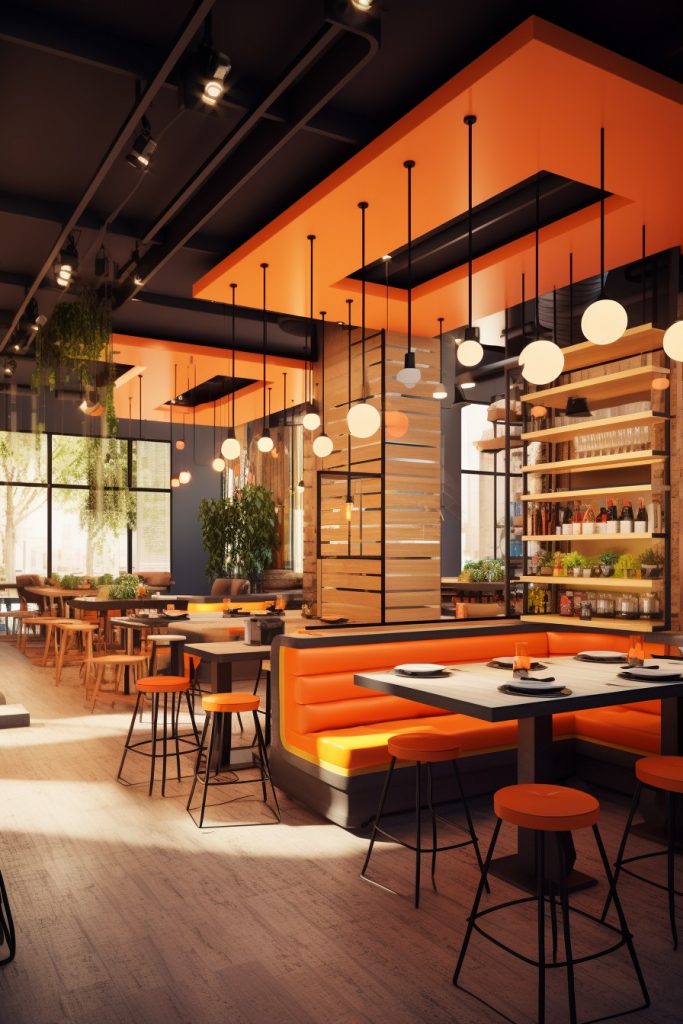
Integrating the open-concept design is a practical way to maintain the flow in the restaurant while ensuring a sense of vastness. Without walls breaking up the space, the layout allows for an airy atmosphere and easy navigation for both staff and diners. It brings about a social dining experience where patrons can engage with each other conveniently.
Key Points:
- 1. Flow and Navigation: Open-concept design allows smooth movement by eliminating barriers, which can be especially beneficial during peak hours.
- 2. Airy Atmosphere: Absence of walls creates a feeling of spaciousness, enhancing diner comfort.
- 3. Social Engagement: Open spaces encourage interaction among guests, making dining a far more social experience.
- 4. Flexibility: Flexible layout options make it easier to rearrange seating or alter the dining space according to changing needs or events.
Sleek, Minimalist Design Elements

Minimalism offers an aesthetic that is both stylish and versatile for your home’s mini restaurant. Adopting a less-is-more approach, this trend can transform your dining space into a chic, inviting area.
Key points to embrace minimalist design include:
- Color Palette: Stick to a monochromatic or neutral color palette. Whites, blacks, greys, and browns achieve a clean, uncluttered look.
- Furniture: Opt for pieces with clean lines and simple designs. Reduce the unnecessary to avoid clutter.
- Décor: Keep it simple. Each item should serve a purpose or bring value.
- Lighting: Natural light plays a vital role. Use fixtures that bounce light around and add a modern touch.
- Space: Leave open areas. This ideology helps create a tranquil, spacious environment.
Remember, simplicity is the essence of a minimalist design. Cleverly choose each element, making sure they are functional but also contribute to the overall aesthetic. It’s all about balance—nothing more, nothing else.
Booth Seating for Comfortable Dining

A favorite feature in many diners, booths provide functional comfort and a degree of privacy. Not only do they add a touch of classic charm, but they also maximize seating capacity.
Here are some key points to apply when incorporating booth seating:
- Space Optimisation: Use the corners of the room for the booths. These areas are often underutilized, and installing a booth generates more seating without sacrificing floor space.
- Privacy Consideration: A high-backed booth can create a private space within your mini restaurant, separating groups from one another.
- Comfort: Upholstered seating in booths is typically more comfortable than traditional chairs. Choose high-quality materials to ensure longevity and provide diner’s utmost comfort.
- Design Flexibility: Booths can be tailored to fit with your restaurant’s style and theme, whether it’s modern, retro, rustic, or something in-between.
- Accessibility: Be sure to consider customers with mobility issues. Make sure to have adequate space around booth seating for accessibility.
Warm, Welcoming Lighting Design

The right lighting plays a crucial role in creating a comforting ambiance. Warm luminescence with yellow tones, as opposed to white or blue light, can help produce an inviting atmosphere, making the dining experience more pleasurable.
Key points on creating warm lighting design:
- Mix and Match Lighting: To avoid dullness, use a combination – overhead lights, table lamps, and floor fixtures.
- Dimmable Lights: Installing dimmable lights allows adjusting brightness according to the time of day or mood.
- Pendant Lighting: This not only serves a functional purpose but also adds an aesthetic appeal. Pendants over dining tables are a popular choice.
- Candlelight: To add softness, bring in candlelight. It can be a real candle or LED imitation.
- Lamp Shades: They play a significant role in diffusing light and should be chosen considering the desired effect.
- Bulb Types: Opt for Edison-style LED bulbs. They offer the warm effect and are efficient.
Remember, the key is to create an intimate, serene space where guests can unwind and feel at home.
Bold Color Scheme for a Standout Look

Bright hues can effectively energize your mini restaurant. To maintain sophistication, consider maroon, navy blue, or emerald green. For a more playful ambiance, opt for candy pink, sunflower yellow, or turquoise. It’s crucial to balance them with neutral shades like white or gray to avoid overwhelming the space. Combining colors wisely can highlight particular sections of the establishment, guide guests’ eyes, and evoke desired emotions. Contrasting colors also promote visual interest, while color consistency can unify different areas. Additionally, colored lighting effects can enhance the restaurant’s ambiance during evening hours.
Key Points:
- Use of bold, bright hues such as maroon, navy blue, or candy pink.
- Balancing vibrant shades with neutral tones.
- Application of color to highlight specific areas.
- Utilization of color contrast to create visual interest.
- Maintaining a consistent color palette for unity.
- Enhancing ambiance through colored lighting.
Hanging Plants for a Green Touch
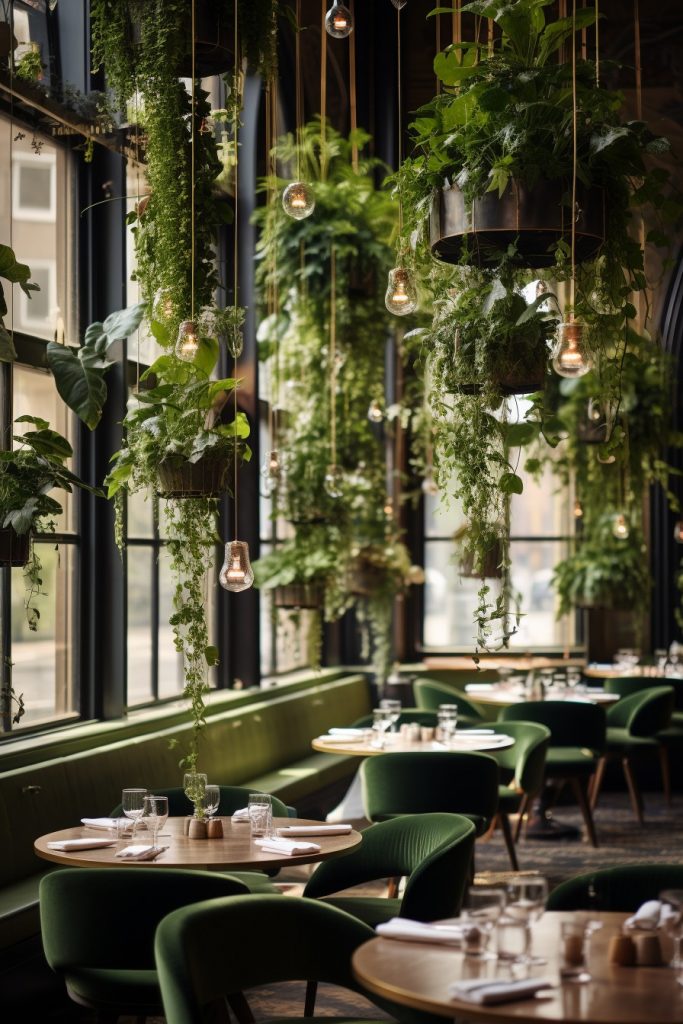
Incorporating greenery brings a lively vibe to your at-home restaurant, effectively improving the ambiance while purifying the air. Choose varied sizes and types of plants to create a textured look.
Here are some key points:
- Variety: Select plants with different leaf shapes and colors. Consider a mix of trailing plants like string of pearls and voluminous ones like ferns.
- Maintenance: Opt for easy-to-care-for plants if you’re not a green thumb. Succulents, snake plants, and pothos are some suggestions.
- Positioning: Place plants at varying heights. Use wall hooks, shelves, and hanging planters to create levels.
- Safety: Ensure plants are securely hung to avoid accidents.
- Rotation: Rotating plants regularly promotes even growth and keeps them looking vibrant.
Remember, the goal is not to overcrowd the space, but to achieve a balance that creates a cozy, welcoming environment.
Feature Wall With Local Art

Injecting a sense of locality enhances not only the aesthetic appeal but also contributes to the authenticity of your mini restaurant. A wall dedicated to artworks from local artists can do the trick. It provokes interest while setting up a visually attractive focal point.
Key points to keep in mind while incorporating this design:
- Sourcing: Opt for local galleries or art communities. It’s also a brilliant way of supporting local talent.
- Curation: Choose artworks that reflect the restaurant’s theme. Vibrant abstract work for a modern vibe, or traditional art for a classical touch.
- Display: Utilize proper lighting to highlight the works. The display format can vary from a single large artwork to a collection of small pieces forming a gallery wall style.
- Rotation: Rotate the works periodically to keep the decor fresh and engaging.
This creative addition to your mini restaurant design not only beautifies the space but can also become a conversation starter among the diners.
Bright Outdoor Lighting for Patio Dining

Harnessing the magic of lighting can turn your patio dining into an enchanting experience. Here’s how you can achieve it:
1. Use String Lights: Hang these across your dining area to recreate a starry night. It’s all the atmosphere without the pollution.
2. Install Lanterns: If you’re going for a classic, warm appeal, lanterns are your best bet. They are available in various designs to suit any theme.
3. Employ Spotlights: This is for you if you love the drama. Use them to highlight architectural elements or significant decor.
4. Opt for Solar Lights: Light up pathways leading to the dining area. Besides being eco-friendly, they give your setup an ethereal glaze.
5. Play with Candles: Not only do they create soft lighting, but also add romance to the ensemble.
Through clever use of outdoor lighting, you can instantly transform a plain patio into your private, starlit restaurant.
Contemporary Artwork for Modern Appeal
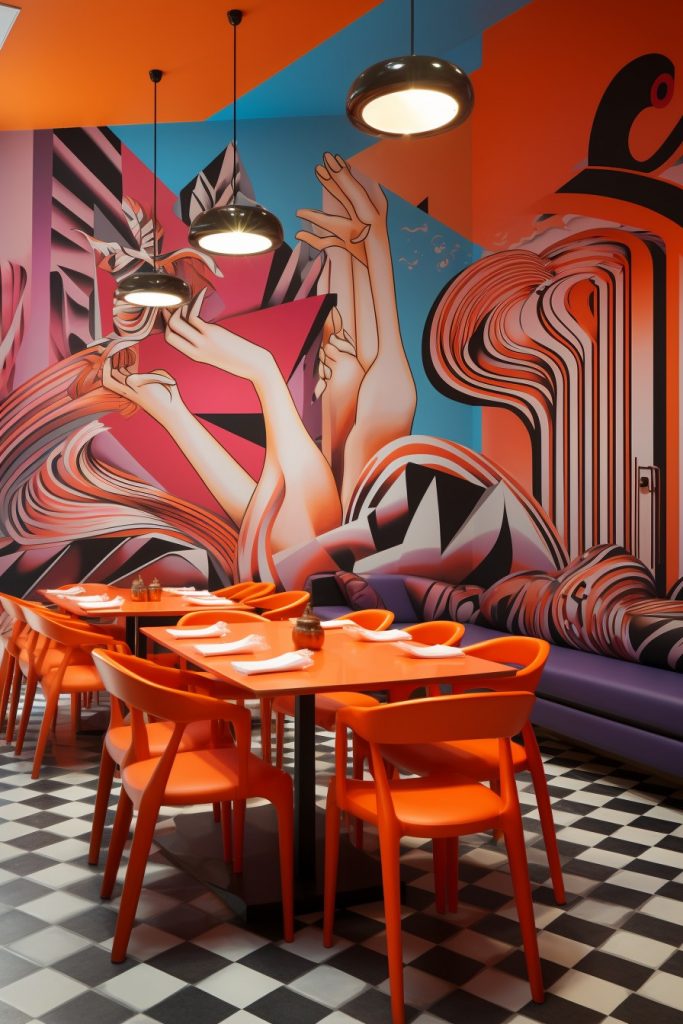
Leveraging contemporary artwork is a strategic move in shaping your mini restaurant into a modern and appealing space. Striking a balance between aesthetics and setting the ambiance is crucial for building a memorable dining experience.
1. Choose Pieces that Speak to Your Theme: Identify works that complement and enhance your restaurant’s theme. Abstract pieces, pop art, or minimalistic line art can form an engaging backdrop.
2. Play with Sizes: Mingle larger statement pieces with smaller complementary prints. This helps create intrigue and visual variety.
3. Art Placement: Position art at eye level in key areas. Well-placed art can spark conversation, lure diners deeper into your space, and subtly guide their behavior.
4. Use Lighting: Proper lighting ensures the artwork isn’t overlooked. Spotlights or pendants can add a dramatic effect and bring focus to the art.
5. Unique Exhibits: Consider hosting local artists for exhibitions. Not only does this refresh your décor periodically but also encourages community engagement.
In essence, contemporary artwork, with its bold colors and strong lines, can be a powerful tool in transforming your mini restaurant into a modern, appealing dining destination.
Classic Diner Design With Jukebox

To bring this design to life, consider the following key points:
- 1. Jukebox corner: Place a fully functional jukebox in a cozy corner. It should be an authentic, preferably vintage, piece to capture the nostalgic aura of the bygone era.
- 2. Chrome accents: Infuse style by incorporating chrome fittings and trims, reminiscent of the retro chrome diner culture.
- 3. Checkerboard floors: Add an authentic diner experience with a classic black and white checkerboard floor.
- 4. Red and white color scheme: Embrace the iconic diner color scheme. Cherry red bar stools and white tabletops will evoke a sense of nostalgia.
- 5. Cozy booths: Install plush booths instead of regular dining chairs for a more comfortable dining experience.
Remember, this design leans heavily on nostalgia, aiming to transport the diner back to the 50s and 60s. It’s all about creating an atmosphere that’s both playful and relaxed, serving as a subtle reminder of simpler times.
Continue exploring:




